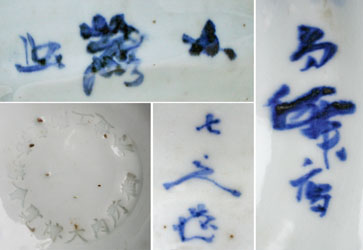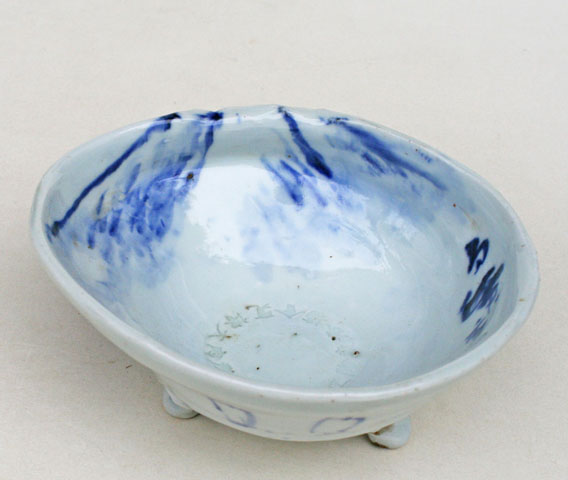Kyôyaki
Haisen, sake rinsing bowl - Mount Fuji and sailing at Miho no Matsubara from across Suruga BaySigned: Hyakusen sha, Bunrin and kakihan, Shichibei
Seals: Gosho-Nai Dai-Hakurankai
Technique: Sometsuke kyôyaki, porcelain with a cobalt blue underglaze decoration Ø 16 (14.4) x 7.2 (6.5)
Date: 1871
Condition: fine
A rare gassaku haisen for which Shônen (who made the decoration of Mount Fuji on the inside of the bowl) and Bunrin (who made the painting of the sails on Suruga Bay with the beach of Miho no Matsubara) collaborated with Kiyomizu Shichibei. It was made in 1871 on the occasion of the Great Exhibition at the Imperial Palace (Gosho-Nai Dai-Hakurankai) in Kyoto.
Shônen’s life-style is reflected in his paintings: bold and full of self-confidence.
He was the son and pupil of the Kyoto Shijô artist Suzuki Hyakunen (1825-1891). At a very early age he already achieved great skill and worked in a spontaneous, bold and impromptu manner. In 1881 he succeeded Kôno Bairei (1844-1895) at the Kyôto Art Academy, teaching Northern Chinese painting, where he taught until 1888. In 1886 he also started teaching at the Kyôto Prefectural School of painting, the same school he attended as a pupil. In his later years Shônen was an extremely influential person in Kyoto art circles, with many important patrons.
Reference:
Morioka & Berry ‘99 p. 106-111
Morioka & Berry ‘08 (# 69)
Aburai. p. 218
Roberts p. 167
Araki p. 2792
Bunrin explored the boundaries of the Maruyama-Shijô style and searched for new interpretations in the Nanga style. He also experimented with new painting methods. Through Kôno Bairei (1844-95), his major pupil, his influence reached well into the twentieth century. Bunrin became the createor of Nihonga.
Bunrin’s father was in the service of the Takatsukase family. When in 1820 both his parents died he was sent to Kyoto to study painting. The head of the Takatsukase family arranged a place in Toyohiko’s studio (together with a lifetime allowance of rice).
Bunrin’s connection with the Takatsukase family, which was connected with the imperial court, might have had consequences if he had not moved to a rural village in Shiga from where he travelled and visited temples to study their collections of Ming paintings. Meanwhile he remained in contact with some of the imprisoned key figures of the loyalist groups.
Reference:
Berry & Morioka ‘99 pp. 58-62
Berry & Morioka ‘08 # 66
Conant p. 321
Hillier pp. 335-338
Roberts p. 11
Araki pp. 689-90
Kyoto '98 p. 280
Shichibei was the eldest son of Kiyomizu Rokubei II (1790-1860). He started his kiln at the gate of Nambokori and Gojo Bridge East before his younger brother Rokubei III (1820-1883) inherited the family business.
Price: ON REQUEST

